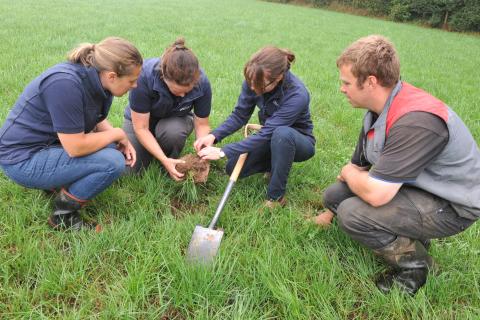29 August 2018
Reseeding scorched fields after Wales’s prolonged dry spell could be false economy because grass plants that appear dead from a shortage of moisture might simply be in a dormant state.
During a joint Farming Connect and AHDB Dairy soil health day in Pembrokeshire, farmers were advised to carefully assess the roots of grass plants in fields where production has been halted by the severe lack of rainfall.
“A field might look as if it has died off but dig up grass plants and look at the roots - if they are springy, if they have a bit of give in them, the plant has survived,’’ explained Ellie Sweetman of NIAB (National Institute of Agricultural Botany).
Reseeding is expensive and should only be done when needed - Irish research figures put its cost at £600-£700/hectare.
“Consider where you need to plough, it might be that you can use slot seeding or over-seeding if you only need to focus on key areas of a field,’’ Ms Sweetman told farmers attending the open day at Moor Farm, a Farming Connect Demonstration Farm at Walwyn’s Castle.
Planting new seed in current conditions is not advisable, particularly with more dry weather forecast, she warned.
Seeds need good contact with soil particles to absorb water and to provoke a chemical reaction for them to germinate and grow.
“There needs to be enough moisture around for the seedlings to get established,’’ said Ms Sweetman.
She urged farmers to get a better understanding of their soils, to know what is achievable on their farms.
“It isn’t necessarily about getting the perfect soil, it is about knowing what is good for your own farm, your soil, about understanding the potential,’’ Ms Sweetman suggested.
“Farmers will know where they have got really good growth on their farms, underneath hedges perhaps. Look at where the best and the worst production is, dig holes and check, establish what the pH is and review how you have managed those fields.’’
But now is not a good time for farmers to check soil for compaction, warned Dr Elizabeth Stockdale, Head of Farming Systems Research at NIAB and a joint speaker at the GREATsoils (Growing Resilient Efficient and Thriving) soils event.
Cracks that have been appearing in soil this summer as a result of the dry weather are good for compaction as they can sort out the problem naturally, she said.
“Try to avoid putting metal into the ground and bashing up the soil where you don’t need to,’’ she advised.
“Don’t treat compaction just because you think you have it. Check the soil and take into account how you have managed that field – consider the size of machinery and animals that have been in there.
“If compaction is an issue then use a machine but set it up specifically for the problem you have, in the right moisture conditions and to the right depth.’’
For selecting the right seed varieties, she suggested that farmers should take the Recommended Grass and Clover Lists for England and Wales to their supplier when sourcing seed and to ask them to explain why they are recommending a certain seed.
“In areas where diseases are prevalent, select varieties that are resistant to those diseases,’’ said Dr Stockdale.
Fertiliser application post-dry spell was also a topic for discussion.
Abigail James, Farming Connect Dairy Technical Officer (South West Wales), said farmers were advised that if fertiliser was applied when the grass was still growing, it will not have been utilised because of slow growth rates.
“The advice by the speakers was not to rush out and apply fertiliser to fields which received it at the start of the dry period because if grass has not grown it will still be there,’’ she said.
Dairy farmer Andrew Rees has secured additional autumn grazing for his herd by taking two paddocks out of the grazing rotation and planting with fast growing grass varieties.
Grass production at Moor Farm had fallen to zero in July and the 263-cow herd was on a full silage ration, fed in the fields.
To extend the grazing season, Mr Rees sacrificed two paddocks and drilled one with an Italian ryegrass and rape mix and another with Westerwold and rape.
“Last year we grew Italian and rape in 18 acres for the youngstock and followed this with wholecrop in the spring which worked well,’’ he explained.
He is confident he should have sufficient forage to see the herd through the winter because the silage he has been feeding this summer was last year’s crop. To boost the clamp this winter, he has also bought a 15-acre standing crop of spring barley to wholecrop.
Two cuts of silage have been taken this summer and, following recent rain, Mr Rees hopes to take a third.
When reseeding he favours late heading diploids in grazing fields and medium to late heading tetraploids in silage fields.

